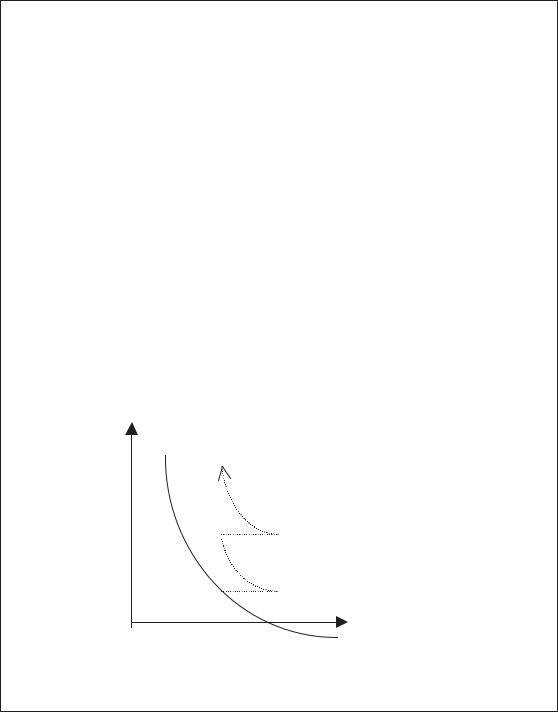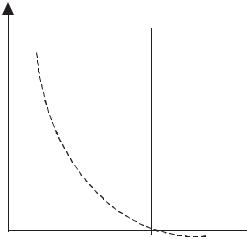
Cleaver Economics The Basics (Routledge, 2004)
.pdf
Box 4.4 Demand management and government budgets
Governments spend money on education, health, transport, defence and a whole range of services to the nation which must be paid for – if not by direct pricing – by levying taxes. The balance of public sector spending on one side, against tax revenues on the other, is recorded in the government’s BUDGET. Note that government expenditure acts as an exogenous injection into the domestic economy whereas taxes act as a leakage to reduce people’s incomes and spending. This fact enables governments to use their budgets in an active FISCAL POLICY to directly influence the circular flow of national income.
Suppose business expectations are pessimistic, investment is less than aggregate savings and financial markets cannot induce further investment, even though interest rates are rock bottom. National income will fall as recession grips the economy. In such circumstances, Keynesian economic policy is for governments to spend more than they tax. If the government’s budget is in DEFICIT then the domestic economy must be receiving the money the government is losing (assuming no outflow of international funds). Private sector investment may be low but net injections will rise if public sector investment compensates to build more roads and hospitals, employ more people and pay them wages. An economy in recession can thus be stimulated if the government makes the injections which the private sector is unwilling to provide. Notice in this example that savings outweigh private investment so therefore the government can finance a budget deficit by borrowing from the financial markets which are flush with funds that no one else wishes to employ. As the economy recovers due to the fiscal stimulus, incomes will grow and along with them tax revenues will rise to pay off the (low-cost) loans the government originally borrowed.
The converse of all this also applies. If investment is greater than savings, injections exceed leakages and inflation threatens, then governments can aim to increase taxes and make a budget surplus to take the heat out of the economy and ensure that aggregate demand attains equilibrium at full employment level and not higher.
© 2004 Tony Cleaver
In his time, Keynes’ writings were so revolutionary that he became the world’s most famous economist and his legacy on the subject as we know it today is immense. His theories and the policy implications that flowed from them changed the accepted paradigm such that the post-Second World War international economy was dominated by governments, think tanks and policy makers of all stripes all advocating demand management policies.
But just as he challenged the orthodoxy of classical economics which preceded him, so other economists have since had to overcome the intellectual stranglehold that the Keynesian paradigm exerted in the post war years.
The most famous economist living today, Milton Friedman, is one who has been in the forefront of re-establishing neoclassical economics and in challenging both the Keynesian notions that market economies are not self stabilising and that they therefore need government macroeconomic regulation.
Friedman, and other neoclassical economists, do not dispute there is a role for government intervention in
(e.g. to break up monopolies and promote competition amongst suppliers, as discussed in the last chapter). But they say there is more likelihood that government spending at macroeconomic level will be actually destabilising and lead to more problems of unemployment and inflation, rather than the opposite.
This neoclassical position, at its extreme, asserts that Keynesian theory gives governments the excuse to increase spending beyond budgets and, once you let this particular genie out of the bottle you will never get it back in. Government spending increases year on year as public officials find more and more reasons to overshoot budgets; budgets are thus revised and yet again they are overspent. The end result is an increasingly bureaucratic public sector that grows with a mind of its own and crowds out the private sector – which loses revenues, dynamism and the potential for supporting the national economy in the long term.
Inflation, Friedman argued, was and is the result of central authorities allowing excessive monetary growth. Cut back the money supplies and you cure the problem. The opposite extreme experienced by the US in the Great Depression of the 1930s was caused by a sudden and severe collapse in money supplies due to a chain reaction of commercial bank failures. Remedy? Governments should set a steady course with
© 2004 Tony Cleaver
money supplies growing at a rate just equal to the rate of growth of all goods and services in the economy and then they should leave the market well enough alone. Markets may not be perfect but they are better than the alternative – ham-fisted attempts by governments to ‘stabilise’ the macroeconomy.
T H E C O N T R O V E R S I A L C O R R E L AT I O N
The Keynesian notion that a country’s aggregate demand determines the level of economic activity was supported by the empirical findings of Professor A. W. Phillips in 1958 which seemed to show beyond contention that, for almost a century, the UK’s rate of inflation had varied inversely with unemployment in a remarkably stable, almost predictable way. As unemployment went down, inflation went up, and vice versa. It thus supported the Keynesian theoretical model that said you either get unemployment if aggregate demand is too low or inflation if aggregate demand is too high. It also supported political advisors who suggested you could get less unemployment, and thus more votes, by increasing government spending.
The Phillips correlation dominated policy thinking of the time. It was an incontrovertible piece of analysis that seemed to prove you had to live with either one extreme or the other or find some not- entirely-happy medium. The compromise that most developed countries chose to live with in the immediate post war years was a degree of creeping inflation. It was thought to be the necessary price for reducing unemployment.
Friedman’s voice (also that of another US economist Edmund Phelps) arguing to the contrary was not heeded outside the field of theoretical economics. Notwithstanding the irrefutable evidence of an inflation/unemployment trade-off stretching way back into the nineteenth century, these two economists separately argued that if governments began spending money to try and reduce unemployment, in effect opting for a bit more inflation, then the supposedly reliable correlation would break down.
Friedman, in a famous address to the American Economics Association in 1967, said that the Phillips’ curve illustrated in Figure 4.7 offered a reasonable prediction of policy alternatives in a world where zero inflation was the norm; that is, where years in which there was inflation were counterbalanced by years of deflation.
© 2004 Tony Cleaver

But as soon as people expected governments to fuel inflation over a continuing period then they would build that into their wage demands. And as soon as that happened, if governments still persisted in their spending plans to reduce unemployment, there was the potential for inflation to accelerate (Box 4.5).
Box 4.5 The trade-off that shifted
The PHILLIPS CURVE PP (Figure 4.7) illustrates data for UK wage inflation against unemployment over the entire period 1862–1958. It shows a remarkably stable trade-off. Friedman predicted, however, that if governments deliberately attempted to peg unemployment to some level B below what he called the natural level A then this original trade-off would inevitably break down as the Phillips curve shifted up and out.
Assume government spending reduces unemployment below A (1) but leads to an increase in inflation (2). Next round wage claims would build in this increase – which would then lead to a fall in demand for labour (3). If government increases spending yet again, inflation now rises to (4). This leads to even greater wage demands – returning unemployment to (5). If the cycle keeps repeating, the end result will be that inflation/unemployment locii explode off the curve: 6, 7, etc.
Inflation
P
67
|
4 |
5 |
|
|
2 |
3 |
|
|
|
1 |
Unemployment |
0 |
B |
A |
P |
Figure 4.7 The Phillips curve and movements off.
© 2004 Tony Cleaver

In the 1970s it was more than economists who took note of what Friedman said. Most of the western world, in reaction to the OPEC oil shocks of 1973 and 1979 (see Box 4.6), experienced accelerating inflation almost precisely as predicted. A shift in inflationary expectations provoked a wage–price spiral and many democratic governments – unwilling to take the political risk of allowing unemployment to rise – opted to spend money instead with the exact consequences as illustrated earlier.
The world seemed to have adjusted to living with inflation – only to find that once started, it was a notoriously difficult process to hold in check. For economists and advisors of the Keynesian school, the events of the late 1970s condemned them to the margins of policy-making whereas Friedmanite analysis and recommendations now captured the centre-ground. The macroeconomic paradigm shifted once more.
Box 4.6 OPEC and the oil price shocks
The Organisation of Petroleum Exporting Countries was formed in 1960 in an accord between original members Iran, Iraq, Kuwait, Saudi Arabia and Venezuela. But it was not until the USA in particular, in 1973, began to import increasing amounts of oil as its own supplies fell short of demand that OPEC could act as a successful cartel. The spark that lit the oil crisis was the 1973 October War between Arabs and Israelis when OPEC shut off oil supplies in retaliation to Western support of Israel. The price of world oil soared 400 per cent between October 1973 and January 1974.
For oil-consumer countries in the rich and poor world alike, the 1970s was a time of painful adjustment to high oil prices and the inflation this fuelled. Just as they thought they were coming out of it, in 1979 oil prices surged again. This time it was the Iranian revolution when the pro-Western Shah of Iran was deposed by Muslim fundamentalists who again shut down sales of Iranian oil. By the 1980s, however, governments in the West had changed and economic policies had changed with them (see section ‘The supply-side consensus’).
© 2004 Tony Cleaver
T H E S U P P LY - S I D E C O N S E N S U S
Economics is not an exact science. Things never turn out quite the way theory predicts since – unlike the ‘hard’ sciences such as Physics – there are so many variables beyond the economists’ control. But for evidence to confirm theoretical predictions as comprehensively as was demonstrated in the inflationary 1970s was really remarkable. Friedman, famous already, became even more renowned and his influence now extended to policies advocated by decision-takers all round the world, just as had been the case with Keynes, earlier.
Any attempt by governments to spend their way out of recessions was now condemned. By extension, almost any initiative for governments to intervene in the economy was heavily criticised. Right-wing, free-market conservatism – with the ascent to power of Margaret Thatcher in the UK and Ronald Reagan in the USA – now dominated the political agenda.
In the short term, it was alleged that a country’s productive resources were more or less fixed and their allocation between competing uses was best decided by unrestricted market forces. Trying to reduce unemployment below its ‘natural’ level by increasing aggregate demand could not increase national income/ output/aggregate supplies one iota – it could only stimulate increasing inflation as already described.
This implies that the original Phillips curve PP becomes super-
seded by the new version: an EXPECTATIONS-AUGMENTED PHILLIPS
CURVE, which is a vertical line at point A (Figure 4.8).
What are the policy recommendations that flow from this? Ignore inflationary meddling with aggregate demand – focus instead on the microeconomic features of the SUPPLY-SIDE of the economy.
Only policies that are aimed at making resources more flexible and responsive to market forces could hope to reduce unemployment and improve a nation’s fortunes.
LIBERALISATION, deregulation, privatisation, removing the allegedly dead hand of government, were all the new buzz words of the 1980s supply-side revolution. Markets had to be set free so that they would restore flexibility and dynamism to Western economies.
© 2004 Tony Cleaver

Inflation
P
 Unemployment
Unemployment
0 |
A |
P |
Figure 4.8 The expectations-augmented Phillips curve.
The tenets of this latest orthodoxy in macroeconomics were now as follows:
●Central authorities varying money supplies cause most of the instability in an economy. Money growth should be fixed at a rate commensurate with that of long-run trend growth of the economy and then left alone.
●There is no long-run trade-off between inflation and unemployment.
●The economy is inherently stable such that if disturbed by misplaced government meddling then it will return eventually to the long-run equilibrium at the NATURAL RATE OF UNEMPLOYMENT.
●The natural rate of unemployment is increased by the provision of welfare payments which allegedly give people an incentive not to work, and by minimum wage laws and protective labour legislation that inhibit hiring and firing workers.
●Future expectations, the actions of unions and the flexibility of prices and wages all impact on inflation and misguided government intervention can exaggerate these influences.
Such an economic philosophy dictates a detailed restructuring of the relationship between the government and the economy as a whole.
© 2004 Tony Cleaver
F i s c a l D i s c i p l i n e
First, supply-side economics requires governments to balance their budgets, live within their means and thereby stop inflationary spending. Loss-making industry should not be bailed out in the mistaken pursuit of trying to protect jobs. Similarly, it also means reducing welfare payments and handouts to workers. This saves government money, lets failing industry fail and prompts workers to move to new, growing firms. On the side of taxation, high MARGINAL INCOME TAX RATES should be cut and the tax base broadened. Such discipline also addresses the problem of incentives (Why should industry strive to be efficient if government bails out failure? And why should the individual work if earned income is highly taxed and unemployment brings you benefits?).
P r i v a t i s a t i o n
State-owned or NATIONALISED INDUSTRIES should be sold off to whichever private investors might be interested (e.g. telephones and telecommunications) and closed down where industries have no buyers (e.g. coal). One-off sales of public industry will net large revenues for the government which can be used to pay off the NATIONAL DEBT and balance budgets over the longer term and simultaneously they remove altogether the permanent drain on the public purse of otherwise loss-making dinosaurs.
D e r e g u l a t e a n d Fr e e - U p Tr a d e
Competition should be promoted wherever possible. Barriers to entry and exit in private industry should be removed. In the public sector, quasi-markets can be introduced in health, education services and in public broadcasting to simulate competition between suppliers. In labour markets, improve labour mobility by breaking up restrictive trade unions that act as monopoly suppliers of labour whilst increasing job information and training to allow workers to move. In finance, remove restrictions on the international movement of money, the barriers to foreign banks, and the demarcation of different loan markets between building societies, banks and all other money houses.
© 2004 Tony Cleaver
P r i c e F l e x i b i l i t y
Release the price mechanism to operate unhindered. The price of domestic money, the price of labour and the price of international currencies should, in particular, all move up and down without fear or restriction. That is, rates of interest, wages and foreign exchange dealings should be determined by free markets and not fixed by some rule, regulation or legislation.
D e - P o l i t i c i s e M o n e y
Last but certainly not least, remove politics from the determination of the money supply – that is, make the nation’s CENTRAL BANK independent of day-to-day control by government. Give the governor of the central bank a target to keep inflation down and under control and leave him/her to get on with it, irrespective of unemployment effects and free from political interference.
The short-term SOCIAL COSTS of implementing these measures have caused much debate. Cutting industrial subsidies and closing down businesses whilst at the same time reducing spending in the public sector must mean increasing unemployment. Such policies combined with reducing and re-targeting unemployment benefits are likely to increase poverty and hardship. ‘Broadening the tax base’ is coded language for increasing taxes on a wider range of goods and services – that is, increasing prices. Reducing marginal income tax rates may leave high-income earners with more money to spend but doesn’t help the lower paid.
Widening extremes of poverty and wealth are the inevitable result of such policies – but this is justified, according to this new classical paradigm, if the value of money and the efficiency of markets is to be restored. It is worth the risk if incentives to work, invest and produce are all improved and opportunities to climb out of the lower income levels are similarly increased. The overall impact on the economy, it is alleged, is to make it more dynamic, entrepreneurial and growthfull. National income will thus grow faster and raise everyone’s standard of living over time. And the quicker these reforms are implemented the better – it will reduce any social costs involved in adjusting to the new economic realities (see New Classical school later).
© 2004 Tony Cleaver

This revolution in economic philosophy – turning back from Keynesian thinking in favour of unfettered markets again – drove major changes in the 1980s not only in the developed countries of Europe and North America but also in the developing world. It was a shift in priorities to address inflation, curtail government excesses and to play down attention to unemployment. The Washingtonbased and highly influential institutions of the International Monetary Fund (IMF) and the World Bank actively promoted these views (see Box 4.7). There continued some disagreement over the short-term costs of implementing the recommended package of market reforms but mainstream macroeconomic analysis was, on the whole, won over by the new consensus.
Box 4.7 The Washington Consensus
The early 1980s, a time of inflation and recession for many in the developed world, saw the emergence of a major debt crisis for poorer countries. The policy package to reduce inflation, listed earlier, meant cutting back money supplies in the rich countries – which inevitably raised interest rates. (A shift back in world supplies forces up the price of money.) Poorer nations that had borrowed from them now faced huge debt repayment charges that they could not afford.
The IMF and the World Bank were asked for help – which they offered at a price. In return for providing financial assistance, these Washington institutions insisted that market-friendly, supply-side reforms must be put in place in all countries that had become heavily indebted. Some might argue this was holding a gun to the head of the poor. Others would insist it is simply forcing bad debtors to put their financial houses in order. Either way, the new economic orthodoxy was spread from policy advisors and governments in the rich world to the poor. It became known as the Washington Consensus and it had a bitter taste for the many whose standards of living were worst affected.
Poor country governments were forced to cut back on costly welfare programmes, to reduce TARIFF barriers and other trade restrictions that protected domestic industry, to devalue their
© 2004 Tony Cleaver
